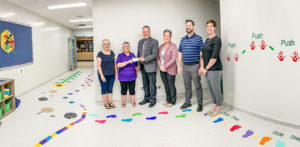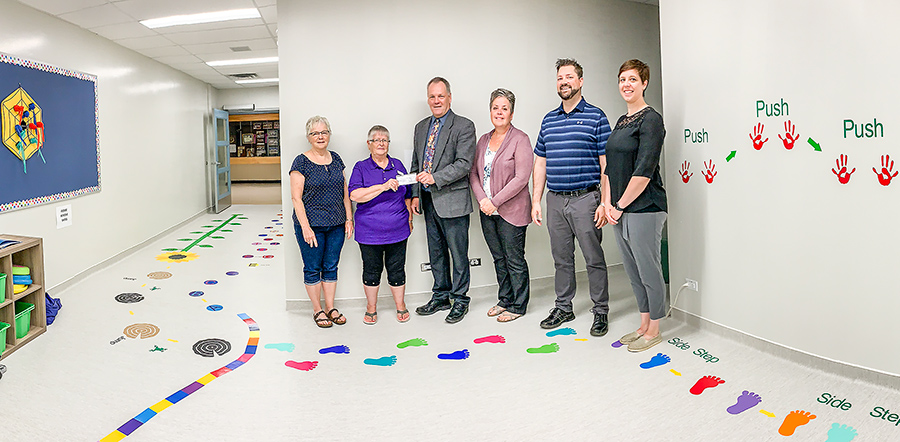
Improving life and learning for students at Killarney School
BY KIM LANGEN
In their quest to help all students achieve their best education, a local school has created a very special area to assist those who struggle with learning and behaviour.
And they call it the Engine Room.
“Why ‘engine’? It’s thinking about your body as being like an engine,” said principal of Killarney School, Terry Beazley, who spearheaded the project. “Sometimes it runs too hot, too fast, and sometimes you need to reduce the revs. And we use traffic colours – like green, red, and yellow – to try and get kids to get in tune with their own bodies.”
The conversion of an area in the school into this new three-part teaching area began last year, he said. And by September of 2018 students in need of help were already benefitting from the program.
“The idea is that occasionally it’s used for extreme times, but mostly it’s for kids to work on their personal development,” said Beazley.
The Engine (Regulation) Room is described by the Turtle Mountain School Division (TMSD) as a room with therapeutic equipment and tools that an identified student accesses on a schedule throughout their day, in order to carry out their specific self-regulation programing, facilitated by an adult.
One of those facilitators is teacher Terry Simpson, who is in charge of K-4 Student Services.
“The whole area is actually in three parts,” said Simpson. “The first room is the Grooming Room, which we built last year. It includes a washer and dryer, a walk-in tub, and shower, a toilet and sink, and a therapy bed. It is all wheelchair accessible, and it was partly funded through Manitoba Education and Training.”
A second part is the Life Skills Suite, which is a kind of kitchen facility and classroom in one, for use by students from K-12. It was started in 2017, and has been upgraded and improved. It’s even being used to help feed students at school who may not get breakfast in the morning.
“Some cooking is done here, and meal preparation, by older children,” said Simpson. “It could be breakfast, lunch, or dinner. Cooking encompasses a lot of skills, such as math, and chemistry. And some of the grades 3 to 8 take turns at making muffins for our breakfast club. That meal is available to all students from K-12, every day at 8:30 a.m.”
The third area is the Engine, or Regulation Room itself, which begins at the entrance door with a series of colourful and attractive steps painted onto the floor.
By slowly following the steps, and focusing on each one and its imagery, an agitated student who is running ‘hot’ will immediately begin to slow down into a more controlled pattern of behaviour, said Simpson.
The steps lead on to other teaching stations, and with adult supervision, the student gradually learns lessons in how to regulate the extreme highs and lows that they might be experiencing.
It’s good for the student – and it’s good for the classroom that they will eventually return to, she added.
“We have around 450 students in Killarney School,” said Simpson. “Around 50 of those children experience challenges with being able to regulate their bodies, and their brains, and the messages that are coming in. The Engine Room helps them self-regulate. We want to get them into a ready-to-learn state. We are being pro-active; we are setting them up notto fail.”
Some of these students may use the Engine Room on a daily basis, and some may need to access the resource two or three times a day, said Simpson.
Setting up a program protocol specifically created for each student and their needs is achieved through the available resources of an educational assistant, an occupational therapist, and a teacher, she said.
“These three can be involved, and Mr. Beazley is very knowledgeable as to what children need when they come in here,” said Simpson. “He’s aware of the programs that are going on. It’s a team approach.”
While Simpson takes care of the students from K-4, student services are also provided by teacher Lisa Blixhavn for those in grades 5 to 8, while teacher Kristin Polnik is in charge of those in grades 9 through 12.
“The three of us work together in scheduling this room, and make sure that if a child needs to access it, there can be time for them,” said Simpson.
So why would children need all this extra help?
For those of us growing up in the 1950s and ‘60s, it might appear as a load of extra work and expense just to help out a few tricky kids – perhaps like the ones we remember that used to cause trouble and mayhem in the classroom, and end up parked outside the principal’s office with a red face. (Beyond that door lay the dreaded strap…)
“It’s a very different approach of doing things,” said Simpson. “Kids have changed. Society has changed. We don’t see kids coming from the same environments that we came from. We see issues like attention difficulties, and sensory challenges – kids that are easily overwhelmed, or get so excited. And I don’t think kids are as resilient as earlier generations. This is a journey we have just begun – the sensory, or engine room – but I have seen the benefits this past year for some students, and have seen kids that can remain in school that were previously being sent home. The kids are learning how to manage their emotions and their behaviour in a more productive way. It looks like they are playing games, but they are learning. It gives us an alternative. There is method behind the strategy.”
By using the Engine Room to help these kids, there is also a spin-off for other students, she added.
“While there are only 50 kids who use this part of the school, the benefits are imparted to all the other students in the school, in that the classroom becomes a more productive environment,” said Simpson.
So how long does it take to see improvement?
“Sometimes it’s just days,” she said. “Sometimes just a change of location is just what a child needs.”
And what about a kid who may have lost control in school? Do teachers have the capacity to manage a student when things go dramatically wrong?
“There are a number of teachers, around 20 adults in total, who are trained in non-violent crisis intervention,” said Simpson. “If I feel I have to remove a child from the school, I would call the parents, if needed.”
So can any student make use of the Engine Room?
“There is a prescription for the this,” said Simpson. “There has to be a reason for children to use these facilities. They are not open to the public; a teacher has to escort a student to the rooms.”
The TMSD guidelines for the Engine Room include some of the reasons students might need support, and the use of the rooms.“It is for students who have been identified by their school team as having difficulties with self-regulation, and/or intensity of sensory input that a typical classroom environment is able to provide,” it states. “This may include children with diagnoses of ADHD, autism, developmental delay, anxiety, post-traumatic stress disorder, or sensory processing disorder. However, it may also include children without any specific diagnoses that are having difficulty with behaviour, attention, motor coordination, and/or regulation.”

STEPS TO IMPROVEMENT – Killarney School’s new ‘Engine Room’ received a boost at the end of last school year, with a $3,000 donation from the Elks. The Killarney Elks and the Manitoba Elks each pitched in $1,500 to help cover costs of the special three-part teaching area of the school. From left are Marilyn Lamb and Delores Mason of the Killarney Elks, and accepting the cheque is Killarney School principal Terry Beazley, along with Terry Simpson, assistant superintendent of Student Services Grant Wiesner, and speech and language pathologist Corrie Wiesner.

BREAKFAST CLUB MUFFINS – The Engine Room is comprised of three parts, and one of them is the Life Skills Suite. It includes a kitchen, where Grade 3 to 8 students sometimes make fresh muffins for the school’s breakfast club, says teacher Terry Simpson (above).

